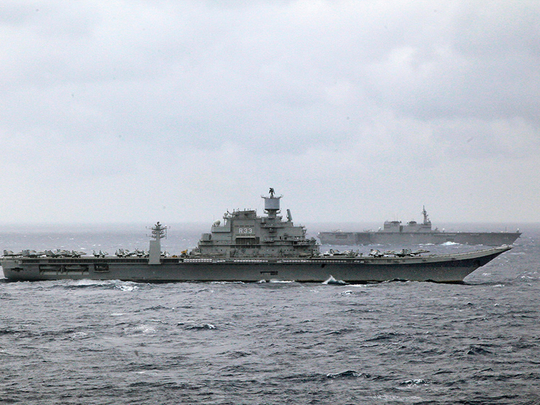
Chennai: Naval manoeuvres in a rough monsoon sea, cross deck flying and crew exchange were some of the highlights of the trilateral ‘Malabar’ naval exercise between India, the US and Japan in the Bay of Bengal.
The sea phase of the exercise between the Indian Navy, Japanese Maritime Self Defence Force and US Navy saw the ships of the three navies participating in the naval manoeuvres at sea.
The movement of ships swiftly and smartly, at close quarters, is as an essential aspect fleet work. The manouevering was aimed at streamlining procedure in ship handling and communications, the Indian Navy said in a statement.
On July 15, the exercise also saw cross deck flying operations, wherein a helicopter from USS Shoup landed on-board INS Sahyadri and JN Sazanami. The helicopter from JN Sazanami undertook flying operations from INS Sahyadri and USS Shoup.
“The cross deck flying operations require a high degree of interoperability and knowledge of procedures of participating ships and helicopters,” the Indian Navy said.
Despite the rough seas and challenging weather, the ships and aircraft of the three navies carried out their assigned tasks in a cohesive manner.
An Indian Navy Sea King helicopter undertook transfer of Japanese personnel to INS Vikramaditya as part of crew exchange programme during the exercise. It was followed by flying operations undertaken by the helicopters of the US Navy ships.
On July 16, INS Jyoti, a tanker ship undertook the manoeuvre Replenishment at Sea with US Navy ship Shoup and Japanese navy ship Sazanami. During this operation, INS Jyoti passed the oil hoses to the US and Japanese Navies to exercise transfer of fuel.
INS Vikramaditya, India’s aircraft carrier participating in the exercise, launched MiG 29K fighter aircraft to undertake combat missions against the US Navy F-18 fighter aircraft launched from USS Nimitz, the USN aircraft carrier, for combined crew training.
In addition to the combat operations, the fighter aircraft from both navies undertook composite formation flying, thereby demonstrating another step in the interoperability aimed through this exercise, the statement said.
Sixteen ships and more than 95 aircraft are participating from the three countries in the exercise that comes amid reports of Chinese warships in the Indian Ocean Region in the name of anti-piracy operations, and Beijing’s aggressive posturing in the South China Sea.
Anti-submarine warfare, operation of aircraft carriers, air defence, surface warfare, visit board search and seizure (VBSS), search and rescue, joint manoeuvres and tactical procedures were the highlights of the war game that kicked off with a harbour phase on July 7 and concludes on Monday.











